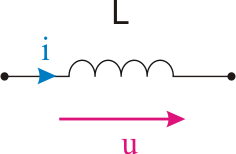An ideal inductance is a dipole that is able to store energy by means of a magnetic field. It consists of a certain number of windings realized from a good electrical conductor which, most frequently, surround a feromagnetic material circuit (good conductor of the magnetic field), whose purpose is to focus the magnetic field lines induced by the current that flows through the inductance.
An inductance is characterized by its specific inductivity L, which depends on the number of windings N and on the magnetic reluctance of the magnetic circuit  , as in the relation:
, as in the relation:

The symbol of an inductance and the reference directions of the voltage and of the current (convention as load) are:

Figure 8 - Symbolic representation of the inductance and the reference directions
The measurement unit of the specific inductivity L is Henry (  ) and considering the previous expression, it is positive.
) and considering the previous expression, it is positive.
In the absence of physical displacement of the element, the voltage at the terminals of an inductance is in direct proportion with the time derivation of the current that passes through it, multiplied by L:

A first observation that can be made in relation to the above expression is that, if the current  is constant in time, the voltage at the terminals of an inductance is zero. This situation corresponds to the reaching of a steady state regime in a DC supplied circuit; in this situation, an inductance is equivalent with a perfect conductor (short-circuit), because
is constant in time, the voltage at the terminals of an inductance is zero. This situation corresponds to the reaching of a steady state regime in a DC supplied circuit; in this situation, an inductance is equivalent with a perfect conductor (short-circuit), because  .
.

In relation to the power at the terminals of an inductance, we can write:

Contrarily to the expression of the power at the terminals of a resistance, the sign of the power at the terminals of an inductance depends on the signs of the current that passes through it and its time derivative; this means that an inductance can absorb or supply energy.
The energy  that passes through the inductance can be calculated:
that passes through the inductance can be calculated:
 ,
,
in which  is the energy stored at the moment
is the energy stored at the moment  .
.
Considering the reference directions of the voltage and of the current that correspond to the convention as load, we can observe:
• if  (the current and the derivative have the same sign), the inductance will absorb energy, rising the stored energy;
(the current and the derivative have the same sign), the inductance will absorb energy, rising the stored energy;
• if  (the current and its derivative have different signs), the inductance provides energy, giving back the stored energy.
(the current and its derivative have different signs), the inductance provides energy, giving back the stored energy.